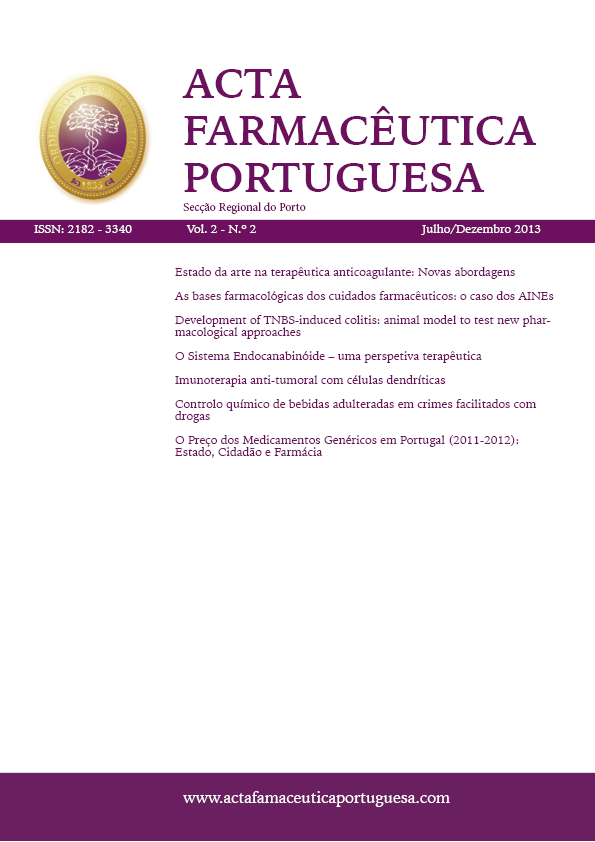As bases farmacológicas dos cuidados farmacêuticos: o caso dos AINEs
Abstract
Polypharmacy – a frequent situation found among the elderly, related to their physiological changes and multiple morbidities – increases the risk of adverse reactions, interactions, drugs misuse and drug-related problems. Knowing that non-steroidal anti-inflammatory drugs (NSAIDs) are widely used among the elderly, the aims of the present study were to assess the potential interactions that may occur between prescribed NSAIDs and other drugs and to create a list of recommendations for monitoring elderly patients taking NSAIDs, in order to prevent or minimize those negative outcomes.
With this purpose, a retrospective study was performed at Centro de Saúde de Eiras (Coimbra, Portugal). The study involved the systematic analyses of the medication regimens of a sample of elderly patients selected from the elderly population of this primary health care unit. Eligible subjects were patients aging 65 or more years and at least with one NSAID included in their therapeutic schemes in the last three months.
A total of 37 prescribed NSAIDs were found in the 29 patients of the sample. 125 potential NSAID-drug interactions were found: 2 minor and 123 moderate. Most interactions occurred between NSAIDs and anti- hypertensive drugs, such as diuretics (17.6%), angiotensin receptor blockers (14.4%), calcium channel block- ers (12.0%) and angiotensin converting enzyme inhibitors (8.8%). The prevalence of interactions between NSAIDs was 12.8%. These interactions can cause adverse effects with particular manifestations in the elderly, such as renal impairment and increased blood pressure.
The pharmacist can develop a relevant role in services such as medication review, to identify these potential interactions, or pharmacotherapy follow-up, in the management of these situations when properly identified. Stresses the importance of positive interaction with General and Family Practice for the safe and efficiency of therapies.
References
Portugal, Instituto Nacional de Estatística, I.P. – Censos 2011 Resultados Definitivos - Portugal. Lisboa: Instituto Nacional de Estatística, I.P. 2011. ISBN 978-989-25-0181-9.
Midlov, Patrick; Eriksson, Tommy; Kragh, Annika – Drug-Related Problems in the Elderly. 1a Ed. UK: Springer Science and Business Media B. V., 2009. ISBN 978-90-481-2445-9.
Guimarães, Serafim; Moura, Daniel; Soares da Silva, Patrício – Terapêutica medicamentosa e suas bases farmacológicas. 5a Ed. Porto: Porto Editora, 2006. ISBN 972-0-06029-8.
California State Board of Pharmacy – Drug Thera- py Considerations in Older Adults. Health No- tes, 2003, Vol. 1, No 7. Califórnia.
Álamo González, Cecilio – Guia Farmacológico de Analgésicos. Revisfarma – Edições Médicas Lda., 2007. ISBN 978-989-8036-09-4.
Tannenbaum, Hyman et al. – An evidence-based approach to prescribing NSAIDs in musculo- skeletal disease: a Canadian consensus. Can Med Assoc. J 1996; 155:77-88.
Castel-Branco, M.M. et al. – Necessidades reais de implementação de novos serviços farmacêu- ticos centrados no doente. Acta Farmacêutica Portuguesa, 2011; 1 (2) 15-22. ISSN 2182-3340.
Drugs.com – Drug Information Online. [Acedido em Fevereiro e Março de 2012] Disponível na Internet: http://www.drugs.com
INFARMED, Portugal – Autoridade Nacional do Medicamento e Produtos de Saúde, I.P. / Mi- nistério da Saúde. Infomed. Disponível na In- ternet: http://www.infarmed.pt/infomed/inicio. php
Trelle, S. et al. – Cardiovascular safety of non-ste- roidal anti-inflammatory drugs: network meta- analysis. Br Med J. 2011; 342: c7086


